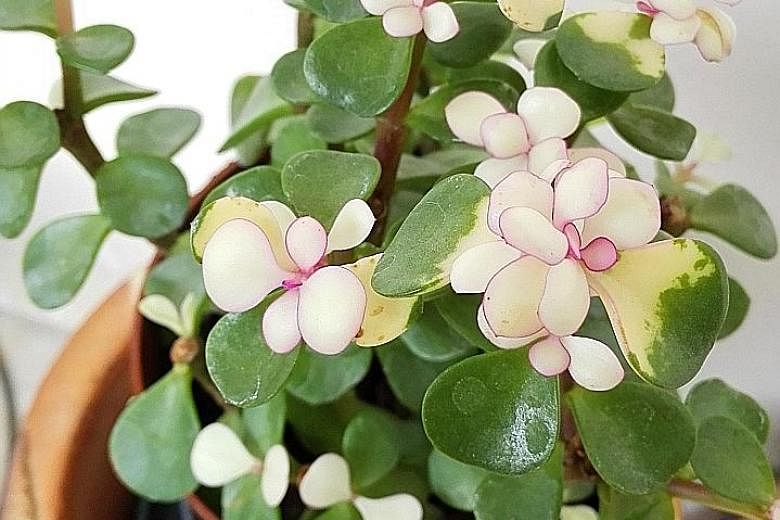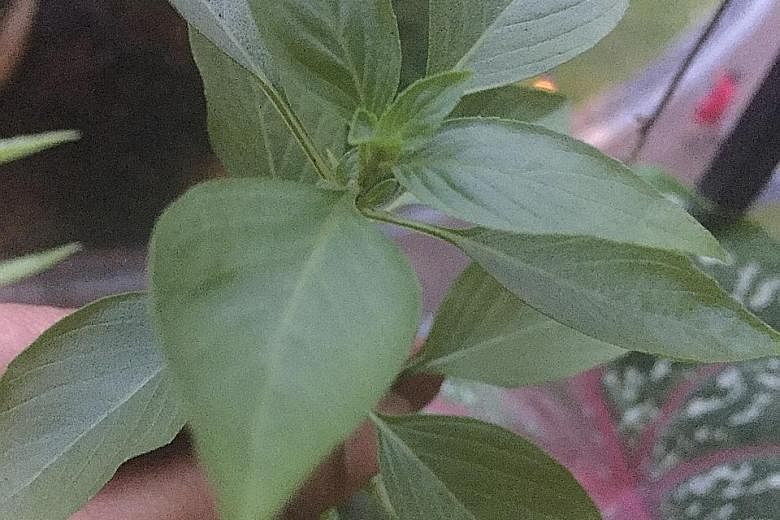Elephant Bush is a succulent and Barbados Cherry has edible fruit
I bought this plant recently. Its new shoots look like flowers because of the pink hue. What is the name of the plant? I also have had this tree for a few years and its fruit look like cherries. Is the fruit edible and what is the name of the tree?
Theresa Pang
The plant with pink and white new leaves is a drought-tolerant succulent that is botanically known as Portulacaria afra. Its common name is Elephant Bush.
This plant can be difficult to grow in Singapore. It needs very well-drained soil to avoid root and stem rot due to overly wet soil conditions. It also requires direct sunlight.
The shrub that produces red fruit is commonly known as the Malpighia emarginata. Its common name is Barbados Cherry.
This shrub produces abundant, highly ornamental fruit as well as small attractive pink flowers. It can be trained into a bonsai.
Its fruit are edible. However, depending on the variety, they are usually quite sour. They are a source of vitamin C.
Too much sunlight for Chinese evergreen hybrid
I bought this plant with bright red leaves last Chinese New Year. However, the colour is fading fast. How can I revive the colour? I have tried placing the plant in the shade and outdoors, but none of this works.
Lee Chee Chee
The plant is probably a Chinese evergreen hybrid. It could be Aglaonema "Pink Anja" or a related hybrid.
Numerous such hybrids are being released by Thai and Indonesian breeders and many look similar, making identification very difficult.
From the picture, the plant has bleached leaves, which suggest that it may be exposed to overly intense sunlight. This plant does best in a position where it can be exposed to filtered sunlight or sun rays that cast a fuzzy shadow for four to six hours daily.
It also does well under an LED light bulb that is placed about 15cm away and switched on for 12 hours daily.
These are shade-tolerant plants, but overly low light conditions can lead to lanky and floppy plants. Plants grown under such conditions are also prone to mealy bug infestation.

Desert rose needs six hours of direct sunlight daily
I have tried for a long time to get this plant to flower, but to no avail. It is placed in the balcony and gets only the evening sun every day. It also gets water daily. I have given the plant both flowering and fruiting fertiliser.
Lu Chee Choon
This plant is commonly known as the desert rose and its botanical name is Adenium obesum. It could also be a hybrid of various Adenium species.
The plant could be lacking in sunlight that is necessary for healthy growth.
It is well-known as a sun-lover. It needs at least six hours of direct sunlight daily.
The lack of light will lead to large green leaves, lanky and spindly growth and the lack of flowers, even after fertilisers have been added.
Bush grape has inedible fruit
I saw this plant in the neighbourhood. What is its name and are the cherry-like fruit edible?
Mui Huang
The vine is botanically known as Cayratia mollissima and is a member of the grape (Vitaceae) family. Its common name is bush grape.
It is mainly grown as a curiosity as it produces hanging bunches of highly ornamental pink fruit. However, they are not edible.
People who have tried the raw fruit have complained of a persistent burning sensation in the throat.
Unripe fruit are reported to contain calcium oxalate crystals which can penetrate the soft tissues of the mouth, causing intense pain.
Let Thai basil-lookalike grow bigger before identifying it
This plant grew in my pot. When I touch its leaves, my fingers have a faint herbal scent resembling a mix of basil and fennel. Is it a variety of basil? Are the leaves safe to eat?
Sanyukta Venkatesh
The plant looks like the Thai basil (Ocimum basilicum var. thyrsiflora).
You may have to let it grow a little bigger and compare it with an existing plant to get a more definitive identification.
Did you have or still have a Thai basil plant growing nearby? The seeds could have been produced by neighbouring plants.
For safety, it is best to trace the history of the growing area before consuming any plant.
•Answers by Dr Wilson Wong, a certified practising horticulturist and founder of Green Culture Singapore (www.greenculturesg.com). He is also an NParks-certified park manager.
•Have a gardening query? E-mail it with clear, high-resolution pictures of at least 1MB, if any, and your full name to stlife@sph.com.sg





